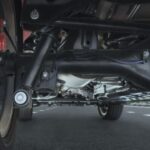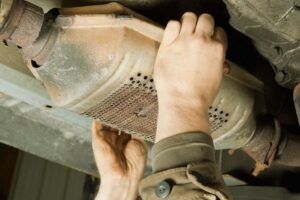Once your car starts making weird noises and as its performance suffers, you might end up in a panic. Several parts can be the culprit, and one of the most common is the CV axle shaft.
The CV axle shaft is an important component of front-wheel drive vehicles. It links the driveshaft and the transmission, allowing the wheels to turn. It transfers torque so that the wheels will turn at a constant speed. Over time, it is prone to wear and will warrant a replacement, especially once the following problems are apparent:
- Presence of grease
- Clicking noise
- Failure of the vehicle to move properly
- Strong vibrations
Read on to learn more about the CV shaft, including its functions and symptoms to watch out for when it needs a replacement.
What Is a CV Axle Shaft?

A Front-wheel-drive Car Has Two CV Axles
Also called the CV axle joint, the CV axle shaft is an important component of almost all vehicles, including crossovers, SUVs, and trucks. A front-wheel-drive car has two CV axles, which you will find at the end of each front wheel.
Stands for Constant Velocity
CV stands for constant velocity. It allows power transmission in a driveshaft at the same rotational speed without increasing friction. It enables the bearings to go through various motions, making a vehicle move. Because of its movements, the components wear out over time, compromising a car’s performance.
CV Axle’s Two Joints
In a CV axle, you will find two joints. The first is the inner joint, which has three rollers on a spider or tripod. This allows the CV axle to expand when necessary. Meanwhile, it is the outer joint that propels the shaft to wheels.
Transfers Torque from the Transmission to the Drive Wheels
One of the main functions of a CV joint is transferring the torque from the transmission to the drive wheels. It will do so at the same speed. In turn, it is what will allow the wheels to turn, allowing a vehicle to move.
When to Replace the CV Axle Shaft
Over time, the CV axle shaft suffers from numerous problems. Act as soon as possible, which will limit its negative impacts on the vehicle. If you do not pay attention, it will compromise the performance and cost of repairs.
Below, we’ll talk about the symptoms that your car needs a CV shaft replacement:
1. Presence of Grease
When grease leaks in your car, you have many potential problems to look at, including a broken CV axle shaft. One of the most common places where grease shows up is on the tire’s edges. It is often dark-colored. The more grease is present, the more serious the problem is.
Inside a CV joint, you will find grease. It has a plastic boot or rubber, which creates a tight seal. When the latter cracks or gets damaged, then grease will spill. In turn, moisture and debris can get in the CV shaft. It will result in eventual failure, including corrosion and minimal lubrication.
2. Clicking Noise
As soon as you hear your car makes a clicking noise, it is easy to assume a variety of problems. For instance, it can be because of the following:
- Low engine oil
- Faulty lifters
- Improper valve adjustment
- Worn-out pulleys
- Damaged spark plugs
At times, it can also indicate that your CV shaft is asking for a replacement.
If the noise happens when you are turning, there is a high chance that it is because of the CV shaft. Often, it is a result of wear and tear. Over time, the joints loosen, making them noisy, especially when turning or driving on a rough road. In many cases, it can be too late to act, and you have no other option but to replace the entire assembly.
3. Failure of the Vehicle to Move Properly
If the vehicle is unresponsive to your maneuvers, it is another sign that you should replace the CV shaft. When this happens, it is often an indication that the problem has already escalated. Hence, it is more difficult and costly to repair.
The problematic joint does not have to separate from the shaft to affect your movement. In most instances, you will find your car moving to one side when you step on the gas pedal. Even if you are driving straight, you will feel that the car has difficulty staying on the path you are heading.
4. Strong Vibrations
Another thing to watch out for is the presence of strong vibrations. When the CV shaft is worn or damaged, your vehicle will end up bouncy as you drive. This is a result of the inability to balance during rotation properly. As a result, the vibrations are more intense the faster you drive, especially on rough roads.
As the vibrations become more intense, it will become more difficult to control the vehicle. Not to mention, it can create an uncomfortable driving experience. Your car might also become more inefficient, making it crucial to address the issue as soon as possible.
Again, what does a CV shaft do? A CV shaft, half shaft, or constant velocity (CV) axle gets its power from your car’s transmission and differential, then transfers said power to the wheels. This power enables your car to move forward.
How to Replace a CV Shaft

Now that you know the signs that indicate the need for a replacement, here are the steps involved in replacing a CV Shaft:
1. Remove the Cotter Pin
Depending on the type of your vehicle, it might come with a cotter pin. It holds the outer axle nut, preventing it from detaching from the CV axle. You will need side cutters to remove the snout of the cotter pin.
2. Take the Axle Nut Off
Work with the axle nut next with the cotter pin out of the way. The easiest way to do this is to use an impact wrench. Consider the size of the nut, which dictates the socket size that you will need for its removal.
3. Remove the Wheel and Brake Assembly
Lift the vehicle using an appropriate jack. Once it is on a jack stand, take the wheel off. With the wheel out, take the brake caliper off. The next component to unbolt is the outer tie rod, which connects to the steering knuckle. If it is difficult to take off, you might need a penetrating lubricant.
4. Remove the CV Axle
Find the position of the joint, which should be at the point where it slides into the transmission. For this procedure, you can use a flathead screwdriver or a small pry bar. Put a catch pan underneath since it is most likely that there will be a transmission fluid leak.
5. Put the CV Axle into the Housing
Now that the position is clear, you can replace the CV axle. Insert the new one into the transmission housing. Slide it until it is thoroughly flushed. Once it is in place, you will hear the clip clink. A rubber mallet can be useful to force the axle in until it is flushed.
6. Return Everything Else
Once you are done putting the CV shaft in place, it is time to put back everything you removed earlier in a reverse procedure. Start with the axle in the hub assembly. Make sure that they are all secure in their respective positions.
Care and Maintenance of the CV Shaft

For the optimal performance of the CV shaft, below are some of the things you can do:
1. Inspect the CV Shaft Axle Often
The most important is to inspect the CV axle shaft frequently. This is an opportunity to identify any problem early. The repair will be quicker and cheaper by addressing the issue before it escalates. Check all components, ensuring that there are no visible signs of damage.
When inspecting your car, you need to get it jacked. This will put it in a higher position to understand better what is underneath. The closer you are to the shaft, the easier it is to see any problem.
2. Keep the CV Shaft Clean
During the inspection, you might see dirt accumulation on the CV shaft. It is thick with filth, so make sure to clean it. Give it a quick wash to get rid of the debris on the surface. This will give you a better view of its current condition, but it also helps maintain optimal performance.
3. Be Careful
Consider the capabilities of your vehicle before bringing it anywhere. For instance, if it is built for highway or city driving, do not use it off-road. Otherwise, the ride will be bumpy, putting unnecessary strain on the components, including the CV shaft. In turn, it will make the latter prone to premature wear.
FAQs
Before we conclude this guide, we’ll answer some questions that you might have about a CV shaft:
How Long Does a CV Shaft Last?
There is no definite answer to this question. It depends on several factors, such as the quality of the axle itself and the driving conditions. However, on average, a CV shaft can last up to 300,000 miles.
How Much Does a CV Shaft Replacement Cost?
Replacing a CV shaft can cost $180 to $410. This cost only includes an aftermarket component’s price without the labor cost. While you can do this yourself, if you are not confident of your repair skills, it’s better to have a mechanic fix this issue.
Can You Drive with a Damaged CV Shaft?
Yes, you can drive even once the CV shaft is damaged. Nonetheless, we recommend against doing so. As soon as you are sure there is a problem, fix it immediately. Otherwise, you will have a bad driving experience. Plus, your car can be challenging to control, which might end up being unsafe.
Conclusion – CV Shaft [CV Axle Shaft Explained – and When to Replace]
A front-wheel-drive car has several essential components, including the CV axle shaft. It transfers torque from a vehicle’s transmission to its drive wheels. At the same time, it also accommodates the suspension’s movement. Without the CV shaft, the vehicle won’t have the power that it needs to move.
Through time, the CV shaft is prone to several problems, and hence, it will need a replacement. Some of the signs that it is going bad include the following:
- Failure to move properly
- Clicking noises
- Visible grease
- Intense vibrations
Once you experience these problems, check the CV shaft immediately to ensure it is damaged and a replacement is necessary.
Read next:



![Rod Bearing [What is It, How to Replace It, and Replacement Cost] rod bearing](https://roadsumo.com/wp-content/uploads/2021/05/rod-bearing-150x150.jpeg)





![Read more about the article Traction Control Light [What Is It and Why Is It On?]](https://roadsumo.com/wp-content/uploads/2022/03/traction-control-light-300x200.jpg)